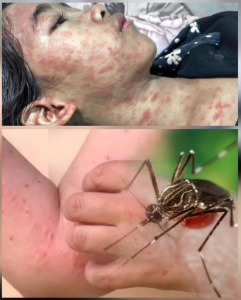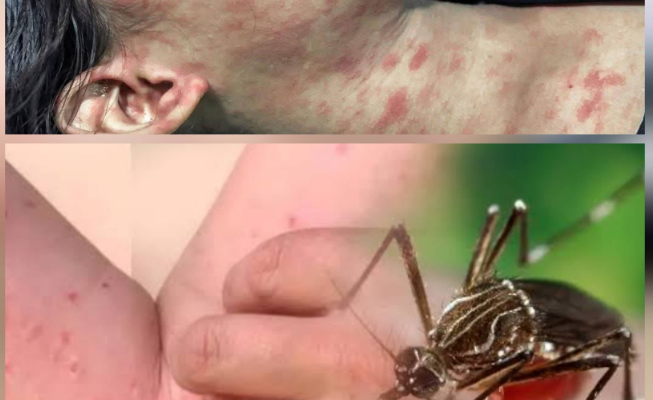
ALERT: New Disease Outbreak in China — Over 7,000 Cases Reported, Symptoms and Risks Revealed
A new public health crisis is emerging in China, where officials have confirmed more than 7,000 cases of the Chikungunya virus, a mosquito-borne disease that has swept through the southern provinces with alarming speed. The outbreak, first detected in the Guangdong region earlier this year, is now the largest recorded wave of Chikungunya infections in mainland China, according to the Ministry of Health and multiple international health agencies. As authorities scramble to contain its spread, health experts are warning of both immediate health impacts and longer-term challenges associated with climate change, urbanization, and the global expansion of mosquito-borne diseases.
The Outbreak’s Origins
The outbreak began quietly in late spring when hospitals in the city of Foshan, Guangdong Province, started recording clusters of patients experiencing high fever, joint swelling, and severe pain. Initially, doctors suspected dengue fever—a similar virus spread by the same mosquito species, Aedes aegypti and Aedes albopictus. However, laboratory testing soon revealed the real culprit: Chikungunya, a virus known for causing crippling joint pain and fatigue that can last for months.
By mid-summer, the virus had spread to neighboring cities and rural areas, fueled by record rainfall, warm temperatures, and dense mosquito populations. The Chinese Center for Disease Control (China CDC) confirmed over 7,000 infections by early August 2025, with unverified local reports suggesting that the actual number of cases could be significantly higher. The World Health Organization (WHO) has described the situation as “a serious regional health event requiring sustained control measures.”
Understanding Chikungunya
The Chikungunya virus (CHIKV) is not new to global health experts—it was first identified in Tanzania in 1952—but its recent geographic expansion has alarmed researchers. The virus is transmitted to humans through the bite of infected mosquitoes, primarily during daytime hours. Once bitten, an infected person may develop symptoms within 3 to 7 days, beginning with a sudden high fever that can exceed 102°F (39°C), followed by intense joint pain, muscle aches, rash, and fatigue.
Unlike many viral infections, Chikungunya’s signature symptom—crippling joint pain—can persist long after the fever subsides. In some cases, patients suffer from lingering arthritis-like pain for months or even years. While most people recover fully, vulnerable groups such as infants, the elderly, and individuals with preexisting health conditions face greater risks of complications. Fortunately, the disease is rarely fatal, but the physical toll and economic burden can be significant.
Why This Outbreak Is Different
China has faced mosquito-borne illnesses before, including dengue fever outbreaks in southern regions. However, the Chikungunya outbreak marks a new and troubling development for several reasons. First, Chikungunya had never gained a strong foothold in mainland China before now, meaning that most of the population lacks immunity. Second, the outbreak coincides with a period of unprecedented rainfall and flooding, creating ideal breeding conditions for mosquitoes. Lastly, globalization and rapid urban expansion have brought people, goods, and insects into closer contact than ever before, accelerating transmission.
Health experts also point to climate change as a major factor. Rising global temperatures have extended the mosquito breeding season and expanded their range northward. “Diseases once limited to tropical zones are now appearing in temperate regions,” says Dr. Zhang Li, an epidemiologist at the Chinese Academy of Medical Sciences. “This outbreak is a warning of what’s to come if we don’t adapt our public health strategies to a changing climate.”
Government and Public Health Response
The Chinese government has mobilized a large-scale emergency response, deploying thousands of health workers to affected areas. Mosquito-control campaigns have been rolled out in every major city in Guangdong, with drones spraying insecticide, public service announcements urging citizens to remove standing water, and strict fines for homeowners who fail to comply. Hospitals have set up dedicated isolation wards where patients are kept under mosquito nets to prevent further transmission.
Local governments are also using technology to aid containment. Drones equipped with thermal sensors are identifying stagnant water sites, while smart surveillance systems track mosquito density in real time. Meanwhile, travel restrictions have been lightly implemented in high-risk zones, and residents are urged to use repellents, wear long clothing, and keep doors and windows screened.
Despite these measures, the virus’s spread has proven difficult to contain. “The challenge is that mosquito-borne viruses depend on environmental factors that can’t be fully controlled,” says Dr. Chen Yu of the WHO’s regional office in Beijing. “Eradication is unrealistic in the short term; the focus now must be on reducing human exposure.”
Global Concern and Travel Advisories
The U.S. Centers for Disease Control and Prevention (CDC) has issued a Level 2 travel advisory for southern China, advising travelers to “practice enhanced precautions” and avoid mosquito-prone areas. Similar advisories have been released by the European Centre for Disease Prevention and Control (ECDC) and the Japanese Ministry of Health. International airports in Hong Kong and Shanghai have increased health screenings for passengers arriving from Guangdong.
So far, no major international spread has been documented, though Taiwan confirmed one imported case linked to the Chinese outbreak in August. However, experts warn that because Aedes mosquitoes are found across Asia, parts of South Korea, Japan, and Southeast Asia could see imported cases during the peak travel season.
Symptoms and Treatment
Chikungunya’s symptoms typically appear suddenly. Patients often describe it as “the worst flu they’ve ever had,” accompanied by joint pain so severe that walking becomes difficult. Headaches, nausea, rash, and swelling are also common. The name “Chikungunya” comes from the Kimakonde language in Tanzania, meaning “that which bends up,” a reference to the stooped posture many sufferers adopt due to pain.
There is no specific antiviral treatment for the virus. Doctors focus on managing symptoms: rest, fluids, and medications such as acetaminophen or ibuprofen to reduce pain and fever. In severe cases, hospitalization may be required for dehydration or secondary infections. Currently, there is no widely available vaccine, although clinical trials for a Chikungunya vaccine are underway in several countries.
Long-Term Risks
While most patients recover fully, up to 30% experience chronic joint pain, particularly older adults. These lingering effects can last months or even years, affecting mobility and quality of life. The World Health Organization has noted that large outbreaks often have lasting social and economic impacts, as workforce participation and productivity decline.
For China, the outbreak has revealed vulnerabilities in its vector-control infrastructure and public health preparedness. “This outbreak will likely change how China approaches mosquito-borne disease prevention,” says Dr. Li. “We need integrated systems that combine weather forecasting, surveillance, and rapid public education.”
The Bigger Picture
The Chikungunya outbreak in China is not an isolated event. It reflects a global rise in vector-borne diseases, with similar outbreaks reported in parts of India, Brazil, and the Caribbean. As global temperatures rise, mosquitoes are thriving in new environments, and urbanization continues to provide them with breeding grounds.
Scientists are calling for international cooperation, including joint research on vaccines, better data sharing, and sustainable mosquito-control solutions. “This is a global problem,” says Dr. Maria Ortega of the World Mosquito Program. “We must treat it as part of the climate and health crisis, not just a local outbreak.”
Conclusion
With more than 7,000 infections and counting, the Chikungunya outbreak in China serves as a stark reminder of how quickly infectious diseases can emerge and spread in our interconnected world. Though not as deadly as some viral outbreaks, its painful symptoms, long recovery times, and potential for chronic illness make it a major health concern. The crisis underscores the importance of preventive measures, public awareness, and international collaboration in the fight against mosquito-borne diseases.
For now, health officials continue to urge calm but caution: use mosquito repellent, eliminate standing water, and seek medical attention at the first sign of fever and joint pain. The lessons learned in Guangdong may shape how China — and the world — prepares for the next inevitable outbreak.

